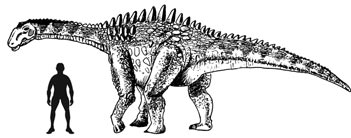Two-Week Museum Dig Provides Stockpile of Dinosaur Bones
The town of Winton in Queensland (Australia), has proved to be something of a “hot bed” for dinosaur discoveries over recent years. However, palaeontologists and field workers from the Australian Age of Dinosaurs Museum, based at Winton, have had to deal with a problem that is exceptionally rare in palaeontology – having too many fossilised bones to excavate and examine at any one time. A two-week long excavation at a location near to Winton, has provided the museum with a “treasure trove” of dinosaur fossils.
Dinosaur Bones
The bonebed has revealed limb bones, ribs, vertebrae and other material belonging to a titanosaur, perhaps one already described or perhaps the fossil discovery relates to an entirely new species of long-necked herbivorous dinosaur.
Palaeontologist David Elliott commented that he had never experienced such a hectic fortnight. He paid tribute to all those volunteers who helped the museum staff to excavate the fossil bones.
He stated:
“Most digs involve a lot of digging in search of the bone deposit but that wasn’t the case with this dig. As fast as we tried to dig around one bone, we uncovered another – there were bones everywhere – giant limbs, vertebrae and two metre long ribs stacked across each other and joined together by rocky concretions. It was impossible to remove them safely without taking half a dozen other bones that were joined to them!”
Cretaceous Dinosaur Bones
Although a large number of Cretaceous dinosaur bones have been found in the Winton area in the past decade or so, scientists hope that these newly discovered fossils will help them to shed further light on the megafauna that once roamed this part of what was the super-continent of Gondwana. It is possible that these fossils represent a specimen of a titanosaur known as Wintonotitan (Wintonotitan wattsi), one of three dinosaurs discovered in this part of Queensland back in 2009.
To read about the discovery of W. wattsi: A Trio of Dinosaur Discoveries from Down Under.
Although the bones have yet to be properly examined and formally identified, it has been speculated that all the material comes from a single, individual animal. However, since very few bones of W. wattsi are known, the scientists will have to wait until the fossils have been cleaned up and prepared to be more certain about what type of dinosaur the fossils represent.
Large Dinosaur Fossils
It is hoped that these fossils, some of them more than a metre in length, will help palaeontologists to fill in the gaps when it comes to the evolution and diversification of titanosaurs in this part of the world. A spokesperson for the museum commented that fossils from more than a dozen sauropods (long-necked, lizard-hipped dinosaurs such as the titanosaurs), had been found in the Winton area. More information about these giant, Australian herbivores had been revealed in the last decade than in the previous one hundred years.
In 2009, fossil bones representing another titanosaur was found, it was nick-named “Zac”. Although far from complete, the discovery of these fossils helped confirm that there were a number of different types of titanosaur living in what was to become Australia during the Cretaceous. The habitat must have been particularly lush and verdant to support such large herbivores.
To read about the excavation of “Zac” the titanosaur: Say Hello to a New Aussie Titanosaur, Hi Zac!
Excavating the Fossil Material
The majority of the fossils have been carefully excavated and placed in plaster jackets for their journey to the museum so that they can be stored properly before the lengthy work of preparation begins. The scientists and field workers hope to be able to return to this site with ground penetrating radar so that they can identify areas where still more bones may be hidden.
An Illustration of a Typical Titanosaur

Picture credit: Everything Dinosaur
The latest fossil finds were just eighty metres from an earlier excavation, a dig site explored back in 2011. The 2011 site provided some backbones and the front limbs of a large titanosaur, it has been speculated that the new bones are from the same animal, both sites may be deposits from the same flood line and the 2011 material represents parts of the skeleton washed downstream and deposited away from the rest of the body.
The fossil material has been dated to around 98 million years ago (Cenomanian faunal stage of the Cretaceous).
Dinosaur Fossils and Exciting Times for Australian Palaeontologists
These are certainly exciting times for Australia’s palaeontologists, glad they have something to occupy their minds what with the Ashes cricket series coming up against England in just a few weeks. Given the Australians current form, they will need some exciting dinosaur discoveries to take their thoughts away from the cricket!
For models and replicas of Australian prehistoric animals including sauropod figures: CollectA Age of Dinosaurs (Popular).






Leave A Comment